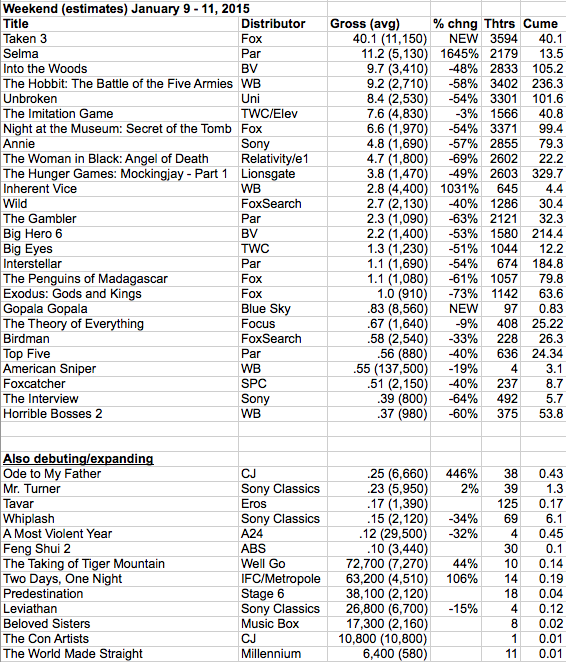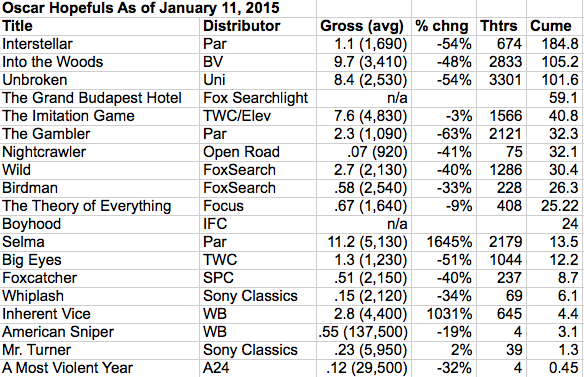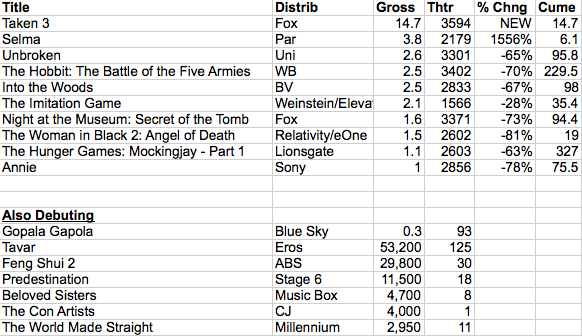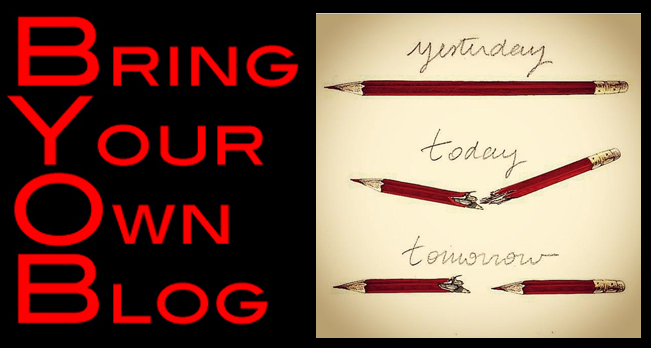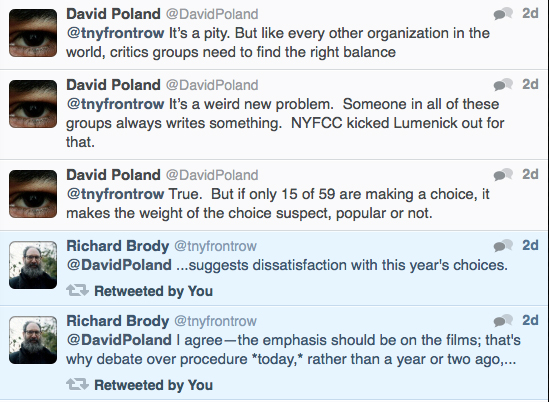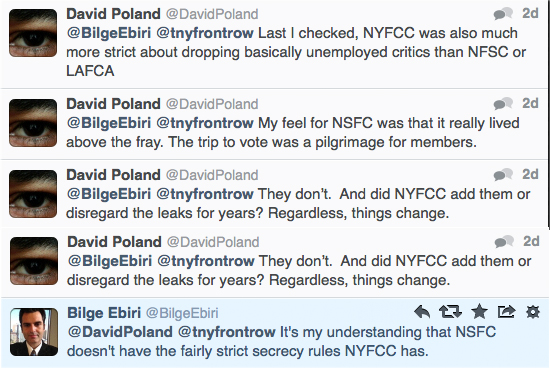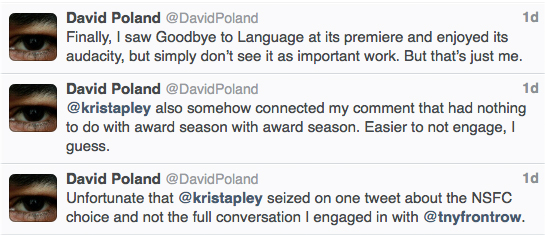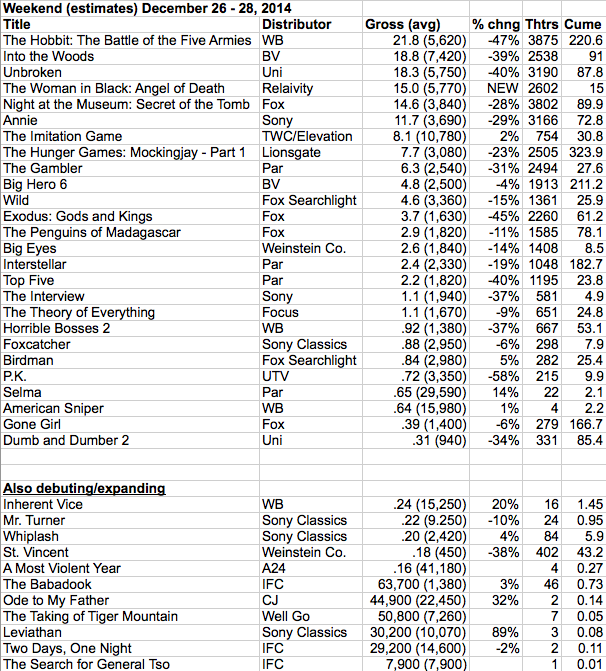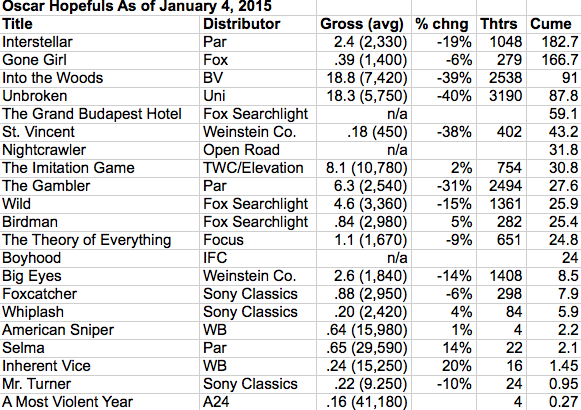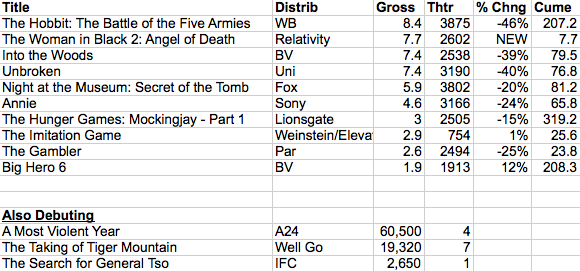The Hot Blog Archive for January, 2015
Everything You NEED To Know From Last Night’s Golden Globes
Weekend Estimates by Special Set Of Skills Klady
Poor Liam Neeson… his second sequel to a very clever, brilliantly marketed low-budget movie is only the second best January opener of all time. Sigh. Taken 4 at 64?
Selma is a delicate piece of box office analysis, in that it is a serious historic drama, it is racial, and there is really no good January comparison to make. If you want to push, the fairest comparisons are from 2012, when choral competition film Joyful Noise opened to $11.2m on 2735 screens and ended up with $31 million. Or from the same year, there was Extremely Loud & Incredibly Close, which was nominated for an Oscar, held on six screens until Oscar nominations (a variation), then went wide to 2,630 screens and had a $10 million weekend and in time, a $32 million cume.
Reach back a year to the October opening of 12 Years A Slave and you’ll see that the Oscar winner never had a single weekend as big as this. But Selma held to a lot fewer screens before expansion and then immediately expanded to 50% more screens than 12 Years ever had in any given weekend. (2179 screens to 12 Yrs‘ 1474 high) 12 Years A Slave (which had about the same budget as Selma) did $39 million before Oscar nominations and ended up with $57 million domestic.
I think that Selma ends up right between the 2012 examples and 12 Years… in the 40s somewhere. There is a much more enthusiastic, motivated audience than Extremely Loud had. But I don’t see how it makes up most of the $27 million head-start 12 Years had going into Oscar nominations weekend.
The number is fine. I will be very cranky if there are stories about how this may not be enough. (Yes, I am looking at you, New York Times.) It would take some big hairy balls to make that argument with frontrunner Boyhood at $24 million. There have only been 24 weekends with a per-screen of over $100,000 in history. American Sniper is the first to ever achieve that for 3 weekends.
And frankly, stories about how the box office for this film has been damaged by the LBJers will also be a load of crap.
Malcolm X never got to 1250 screens in 1992, made $48m domestic, and didn’t get nominated. Bobby (which wasn’t really about Bobby Kennedy) got to 1670 screens, made $11 million domestic, and didn’t get nominated. The Butler (also not really about the presidents who were served) was amongst the most financially successful of these films… certainly the biggest box office. $116 million domestic… no nomination.
Oliver Stone got Best Picture nominations for two of his three title-character historic dramas. JFK, all the way back in 1991, was never on as many as 1,400 screens, but that was also the era of the February Oscar nominations announcement, so the December release had $58 million in the bank before being nominated and added another $12 million. Stone’s Born on the Fourth of July maxed at 1434 screens, but also managed a significant gross – $49 million – before February 13 nominations, adding $20 million after (and losing to Driving Miss Daisy… ahem). And Nixon never got to 1,000 screens, did $12 million, and didn’t get nominated.
If you look at this history, what strikes me is that “movie star = box office.” Anthony Hopkins has never been a big box office draw as anything but Hannibal Lecter, brilliant actor though he is. But Denzel (still rising at the time, but Denzel), Kevin Costner at his height, and Tom Cruise all did good business with these movies (though not hitting $100m was considered a blemish on Cruise at the time and Costner had $100m domestic grossers on either side of JFK.)
The Butler was an extraordinary anomaly that somehow didn’t feel like History because it was one man’s story, but had the advantage of some of the most famous guest-starring appearances in history… a dramatic Night at the Museum, if you will. It was more along the lines of The King’s Speech, which was “a true story,” but didn’t carry the burden of being directly about someone with whom we were deeply familiar.
I am guessing that Selma will not get to $48 million domestic… but will be nominated. Without a movie star. Without high-profile director (going into the release, at least). Expecting more would be a bit ungracious. And who knows? Maybe Selma will break out and do more. Anything is possible. Historically, however, the expectation would be that this and next weekend (a 4-day holiday in honor of the film’s lead character)will be the height of Selma‘s box office run.
And another note… not sure when “All The Way,” the Bryan Cranston-starring LBJ drama from Broadway will land on HBO, but it was acquired almost exactly a year ago to be made for the network on what would have to be a pretty short schedule. Hmmm…
Dynamic duo of disappointment (to some of us, at least), Into The Woods and Unbroken, both passed $100 million domestic this weekend. I often caution that The Academy is more middlebrow than pundits think. Could these films be in the Best Picture mix on Thursday, surpassing some of the hot critics’ darlings? Yeah. it’s that kind of year. This is the same argument that still holds out hope for Gone Girl to get a Best Picture nomination.
The Hunger Games: Mockingjay, Part 1 should pass Guardians of the Galaxy as #1 film of 2014 by this time next week… possible a couple more days.
And the contenders chart three days after nominations closed… including the still amazing American Sniper per-screen of over $135,000. There have only been 27 $100k per-screen weekends in movie history. American Sniper is the first time any film has done it 3 times. Only two other films have done it more than once… both Disney animated films (Hercules and The Princess and The Frog). Obviously, there are not a lot of times where a film stayed on few enough screens to hit this number for 3 weeks. (Only one film has ever hit this number on more than 6 screens, Precious, on 16.) But Warner Bros and Clint Eastwood are sticking to their release plan… sure and steady… oh so Eastwood.
8 Comments »Friday Estimates by Klad3
Taken it to the bank. The reviews on this one are pretty terrible, but while this opening won’t match Taken 2, it could take the record for a January opening… or come up a little short. But either way, this movie will be close to $100 million domestic when all is said and done and will add more than $125 million internationally to make it yet another cash cow, even if it’s not quite Lucy for Luc Besson. Looking forward to “Taken 4” with Shia LaBeouf as the middle-aged replacement for Liam Neeson.
Selma‘s expansion from 22 to 2179 screens is a success. It is not the explosive box office event that some expected. But it is more than solid for a small film, even with a big distributor. I can’t really find any solid comps for the film. The only context that I have made any headway with, after exhausting the question of January expansions, is in the last decade of Oscar contenders, with Zero Dark Thirty and Her. But neither is a great fit. ZD30 expanded better both in gross and per-screen, but still topped out under $100m domestic. Her didn’t expand as wide (1729 screens) in January and never had a weekend as big as the one that Selma is currently experiencing. Will the film get a combination bump from Oscar nominations and Martin Luther King Jr Day next weekend? Right now, it looks destined to do $40-60 million domestically.
The Unbroken/Into The Woods twinsie thing continues, as Unbroken puts a little distance between them on Friday, but is still a few million behind the musical overall. It’s one of the oddest box office things I have ever seen. Both films should crack $100 million domestic this weekend. Both are looking at a bit under $120 million domestic in the end. Neither has done much internationally yet.
Hobbit 3 will close in on $800 million worldwide this weekend.
The Imitation Game remains strong and will pass $40 million domestic this weekend. The rest of the Oscar pack will be looking to return to the Top Ten after nominations next week.
(10:15a – Chart corrected to reflect mistakes on Imitation Game and Museum daily grosses)
7 Comments »One Last Time: How Sony F***ed Up The Business Of “The Interview”

I’ve written this 20 ways, but in honor of another series of bizarre articles about how GREAT Sony has done with The Interview, I feel compelled.
1. $30 million is a record for digital delivered product from Sony. But it’s not the record for the delivery system. That was set 3 years ago with Bridesmaids. $40 million and some. Now… it is possible that eventually, Sony will hit that number, perhaps even pass it. But not by much.
And let’s keep in mind… the President of the United States of America helped market this movie. It was leading the news for nearly a week. No movie has had this kind of press attention before an opening since Gone With The Wind… and that was before TV or the internet (obviously).
Also… the film did $15 million in business from a very limited, not well-traveled digital road in its first week. In its second week, it had every possible digital VOD platform known to mankind. That is the equivalent of going from 300 screens to 2500 in theatrical… and even with all the hype and the benefit of people home for the holidays, the gross for Week Two was the same as for Week One.
It seems they blew the possibility of a Netflix deal, which would have been an event-driven one-off worth, in my estimation based on Netflix’s history, $8m – $12 million. But it’s not happening. And it will not ever happen unless, someday, Netflix does a Sony theatrical streaming deal again… which is unlikely in this decade.
For bookkeeping purposes, let’s go crazy and say they get to $50 million in digital dollars. That’s about $30 million back to the studio.
And let’s say that the digital sales on The Interview had the studio waited for a wide theatrical run would be $15 million. About $10 million back to the studio.
Sony is now up $20 million! Huzzah!
2. Theatrical for The Interview is now $5.2 million domestic. It will never get to $7 million.
And it is unclear at this time whether this film will ever have a proper theatrical release in the rest of the world.
So how do we figure out how much this film would have made in domestic theatrical had Sony offered its partners in exhibition the opportunity to release The Interview without day-‘n’-date VOD a week or two after Christmas? Well, the film was tracking to open to around $20m – $25m. Let’s take away the holiday weekday advantage. And let’s average out the 6 comedies Seth Rogen has starred in starting with Pineapple Express. So yeah, he gets the benefit of Neighbors, but the low ebb of The Guilt Trip (starring an older lady who seemed to keep Rogen’s core constituency away). The average is $72 million. I think this is a low projection, based on Rogen’s last two films both doing over $100m domestic, but I am giving Sony all the rope I can.
That’s $40 million back to Sony.
Same average of six films for international brings that number to a low $20 million or $10m back to Sony.
Now keep in mind… this is all being very, very conservative about theatrical, given the enormous media hype around the film.
Still… Sony down $47 million in a very conservative theatrical guesstimate.
Sony is now down $27 million from the minimum it stood to make had it skipped window-less VOD.
$33 million back to Sony projected from theatrical and digital. $60 million back with a theatrical window and normal VOD.
3. The next financial question is how quickly Sony can get The Interview out of DVD/Blu-ray. And when it does land (February?), will it sell a single added disc from coming out earlier than the normal window?
Given that Neighbors has, according to the limited source I have for this, sold just under 1.5 million units on DVD/Blu-ray, generating about $25 million or about $18 million back to the studio.
Even with all the notoriety, I don’t see The Interview doing more than 2/3 that amount of business. $12m back to Sony, either way.
$45m under the current circumstances (best case scenario). $72 million back waiting for proper theatrical (worst case scenario).
4. Sony’s deal with STARZ prices films within an overall structure based on theatrical performance. I have no idea whether The Interview is somehow exempt from this deal because of the variations away from the norm in this situation. The fact that there was ever any discussion about putting The Interview on Netflix presume that there was some flexibility there. Perhaps STARZ was open to selling off the rights for a price. I have no way of knowing.
However… one has to figure that on paper, The Interview will now accrue about $1 million from STARZ for its pay-TV run and that it would have been about $15 million if it had a proper theatrical release.
$46 million vs $87 million.
5. Conclusion. There are other income streams, including free cable and international TV. There can be a lot of dollars there. But with the value on the product reduced by the nonexistent theatrical and the controversy, there is no real way of valuing The Interview for this purpose. It may well be that the Netflix conversation was for its international territories only.
Another international problem is that the high drama that occurred may have actually inspired a higher level of piracy than normal. Curiosity combined with unavailability = trouble.
I could be wrong, but I think the most optimistic take on the total revenues for The Interview at this point is about $55 million all in.
And i think the least optimistic possible assumption on a slightly delayed, but wide theatrically driven release is $105 million all in.
There is a very real chance that the spread would be more like $45 million (loss of $20 million) vs $130 million (profit of $50 million, considering added marketing costs).
But with a production cost of $45 million and $20 million of committed marketing, Sony will likely take at least a $10 million loss on The Interview as they handled it. Versus a minimum $40 million profit.
And here is the part where the “it’s the future” lie is derailed.
Say you are one of the other majors… or Sony for that matter. Something terrible happened here, but the upside was endless, pro-product media hype and worldwide discussion about a movie that was likely to be a hit, but was never going to get past $200 million worldwide… not a phenom. And with all of that hype, plus $20 million in marketing, the VOD numbers still won’t likely crack $40 million.
It puts VOD back at the start. If this movie can’t smash records, what movie ever will?
The answer is always, “Harry Potter 7B.” And yes. If you opened the Potter finale on VOD, day-‘n’-date with theatrical, I would think you could get no fewer than 10 million households in the US to rent the film on opening weekend at a price point between $10 and $20. Figure you lose 20% of your theatrical opening, but you still get a $136 million opening at 55%, but you get $200 million at 70% in the same weekend. $94 million vs $225 million back to the studio in one weekend.
Then the questions… do you end up losing $100 million in gross/$45 million in returns, making it a $200 million domestic grosser, because you have reduced demand so dramatically?
So what? You’re still up $85 million. But have you damaged Home Entertainment demand going forward?
And the biggest issue… if you reduce theatrical by 20%, what percentage of movie theater screens will be shuttered? I would guess no less than 40% of screens would be gone within two years of mainstreaming day-‘n’-date.
But yeah… there might well be some serious upside and simplifying if you are pushing out a Harry Potter sequel day-‘n’-date. But what about the other dozen films you are releasing that year? How do they stand out when you are trying to get people to pay more than a movie ticket price to watch the movie on their TV screen?
The only reason day-‘n’-date isn’t here yet for wide release movies – and you know the studios have been jonesing for it for 20 years (including in the heat of sell-thru DVD) already – is because it just doesn’t work financially. The impulse to look at how much marketing a studio can save in marketing the first Home Entertainment window at the same time as theatrical ($20m or so) is tempting, especially as DVD drops, VOD treads water, and the sooner you get through that first window, the sooner you can get to pay-TV and/or streamers like Netflix.
But when you get serious about the numbers, the idea of flattening the first window is not attractive at all… especially as DVD drops and VOD treads water. The theatrical revenue, though it is not as dominant a piece of the pie as it once was, is still extremely significant. And keep in mind that the streaming window is still very small for most product from most studios, even with Netflix doing well and Amazon and Hulu chasing.
Who is streaming Hobbit 3? HBO. Who is streaming The Hunger Games? Netflix for a very short period, c/o the now underpriced, non-exclusive EPIX deal. Where can you watch Marvel movies stream as part of a subscription deal? Nowhere. (That last one will change when Disney lands at Netflix in 2016.)
Once you have a deal, as Disney does, with Netflix, there may be elevators in the deal for performance. But the difference between a movie like Avengers making $800 million worldwide and $1.4 million worldwide will not be felt profoundly in that window. But the $300m+ in box office revenue will continue to be a huge differentiator.
The magical thinking that you can be in the big movie business and generate hundreds of millions of dollars with each of your films while eliminating all and any risky steps is insane. And the fact that you are over 30 and would really like to be able to watch whatever you want whenever you want at a reasonable price? One of the most minor considerations of all.
Added note: Time Magazine, please publish people on this subject who know that the gross revenue doesn’t all get returned to the studio in any window.
17 Comments »2014: My Best Films Of The Year – The Top 10/11 (Part 2 of 2)
As I noted in Part 1 of this year-end wrap-up, I didn’t find bringing this list down to ten to be terribly difficult. I don’t quite know why. There are some films in the other 32 “runners-up” that could have moved into this list. But there was no movie gnawing at me that I feel terrible about not including. It was a good year for films, but it was a year of relative subtlety.
There is this one glitch. A quirk in the Box Office Mojo charts that I used to lay out the year for picking somehow didn’t offer up A Most Violent Year, so it didn’t make either list. And just this morning, I was discussing with a friend that the film was in my Top 10, because I knew when I wrote the piece about the “runners-up” that it wasn’t there. So it had to be in the 10. But it wasn’t.
And now it is.
J.C. Chandor’s third feature has a quality that runs through this entire list. It is a bit inexplicable. It is profoundly more than the sum of its parts.
It is true of many films on the “runners-up” list as well. Blue Ruin, Foxcatcher, Leviathan, Two Days, One Night, Tales of The Grim Sleeper, Under The Skin. All films with a deep emotional undertow.
Big Eyes – Perhaps the most shockingly underrated film on this list. This is one of the great coming-of-feminism movies ever made, right up there with An Unmarried Woman and Belle de Jour. The take by Alexander and Karaszewski is nothing like those other films. The issue of feminism is barely ever touched upon. But Margaret Keene, as portrayed by Amy Adams, is a woman with the talent to be successful, but is forced (in many ways) to rely on a man, who shows her no respect… until she finds her voice and demands her place. Tim Burton’s skill as a director is in evidence, but I am afraid, also a distraction as viewers go in with the expectation of something wilder. You will find no better acting performance this year than Amy Adams’ work here.
Birdman – Alejandro Iñárritu has been a genius in search of the right tone for his vision. He finally found it in this pitch-black comedy. Just turning 50, he finally stopped trying to tell the world how to feel and just got to telling the audience how he feels and let us participate in the journey. The result is a glorious ride, perhaps my favorite film of the year, an instant classic. Not only is there not a bad performance in this film… there is not a minor role. (Okay… the brilliant Merritt Wever is a bit underused. But aside from that…) Michael Keaton gives it all up, including his 63 years of aging. Edward Norton, Emma Stone, Naomi Watts, Andrea Riseborough, Zach Galifianakis, and in just a few screen minutes, the amazing Lindsay Duncan. Wow wow wow wow wow wow. And in the end, the mysteries of this film remain mysterious… and fascinating… and glorious.
The Book of Life – My favorite animated film of the year going away, this is a film doing what mainstream of animation has stopped trying. Pixar may flip that script again next summer with Inside Out. But for me, this simple tale of a girl, two guys, and two competing “gods” is endlessly inventive, wildly beautiful, fearless about mixing and matching genres within sequences, and manages to deal with life and death in a way that kids won’t fear. This is one that got away.
Boyhood – Rick Linklater is one of those rare directors who is always busy, makes films of many different sizes, shapes, and tone, and always delivers something compelling, whether the overall film is great or not. Contemporaneously with cutting the edge with the second and third films of the “Before” series, Linklater and his financial partners at IFC were doing something didn’t have to be a disaster to be money thrown down a pit. It could have just been not very compelling. But this film is profoundly compelling, not showy, but singular as cinematic experiences go. Life is not a before and after… it is an incremental journey. Everyone seems to have their favorite moment or favorite character from the film. That’s a sign that there is a buffet from which to choose. And as an added bonus, it couldn’t happen to a nicer guy.
Calvary – Usually you either get The Clock approach to a mortal threat or the slow, thoughtful consideration of life. This film, written and directed by John Michael McDonagh (best known for The Guard), manages to deliver both. At the center is the ever epic Brendan Gleeson as a priest, whose life is threatened—though he personally has done no known wrong—in the first sequence of the film. Thinking that your life may end in just a few days changes everything instantly. And this film is as demanding as it is generous.
Frank – I don’t know why I loved this film… but I did… and I do. Domhnall Gleeson is the one taking the journey, trying to find his way. Michael Fassbender is the man under the giant paper mâché head, who somehow manages to give a rather remarkable performance while utterly obscured. This is as weird a road trip as you will ever have. I won’t try to explain it. A film you feel.
Fury – I thought this film did everything you could ask of a modern war movie. Firstly, it isn’t about sides (though there is no doubt of which side we are on). It’s about the men in the tank… the family… trying to survive… constantly aware that the odds are against them, even in the last days of WWII. Nothing could be more iconic than The Existing Family, The New Kid, and The Father Figure Trying To Keep Everyone Alive. Every man in the tank is a type. But the actors manage to find truth in each of these iconic figures. And the sequence in which Pitt’s character tries to find a moment of humanity in the midst of the war is right there with the most powerful and memorable work of Lean or Ford or Boetticher.
The Gambler – I know that a lot of people will not like this movie at all. There are some clear flaws. But the beating heart of this thing got me and got me good. A meditation on doing everything you can to fuck your life up on the sheer possibility that a better self lies on the other side of your bottoming out. Mark Wahlberg gives one of his rare deep acting performances. This is not a movie star turn. This is commitment. Jessica Lange and (wow) John Goodman are mighty mighty mighty in just minutes of onscreen time. Brie Larson is wasted, as her character is not as central to the story as was Lauren Hutton in the original Karel Reisz film. But this is one of those films that I will get hooked on every time I run into it on the tube… I see it coming.
Inherent Vice – I’m not a stoner, but Paul Thomas Anderson got me stoned with this movie. And I guess I am still high, because I can’t really explain what the hell this film is doing on my Top 10… but it just demanded a slot. In a year of movies whose surfaces are not as rich as their underbellies, this one is all underbelly. I feel no need to get into how good all the performances are. Music. Image. Just floating in my mind, man.
A Most Violent Year – A movie that isn’t about the violence of the 70s, but about the violence in our lives that we deny every day. Abel is the good guy in the movie of his life, never allowing himself to believe that he might be the bad guy, even by association. He’s not stupid. He’s quite bright (perhaps not as bright as his wife), but reality just isn’t the address at which he wants to live. He wants to believe that he did it all himself… or at least has clean hands. But when you aspire to lead leaders, you’re going to get dirty. I would love to see the movie in which Abel meets The Gambler‘s Jim Bennett… the man who can’t take responsibility for what he causes and the man who takes responsibility that isn’t even his. Hmmm…
Nightcrawler – Dan Gilroy and Jake Gyllenhaal deliver perhaps the creepiest movie character since Freddy Krueger… except this guy doesn’t go away when you’re awake and you don’t have to live on Elm Street to find him. I said just after I saw this the first time that it isn’t quite Chayefsky. And it isn’t. But damn it, who the hell else is out there chasing that incredibly high bar? The movie is about TV news, yes. But it is about so much more. It is about the choices we all make… the compromises… the mission creep. We aren’t all Louis Bloom… but most of us look away from a Louis Bloom now and again, preferring just not to think about it.
And that is it. A group of films that I think will linger with me (And be repeatedly watched) for years to come.
I can only hope that you loved your movie year. Happy New Year. Onwards 2015!
My Best Films Of The Year: Part I
19 Comments »Twitter Games & The NSFC Vote
So I decided to take the week off of Twitter when, shocker, a couple of writers decided to use one tweet of mine in a misleading way to make their point.
The issue was the NSFC choice of Goodbye to Language by Godard.
I tweeted (and the lower tweet precedes the higher in these clusters)…
These tweets were made within 90 seconds of one another. But both writers with an ax to grind (the high hat can get very sharp) chose not to include the first tweet, which clearly informs the second. One of the guys, Jason Bailey, didn’t even bother to quite the whole tweet, avoiding any indication of a continuing thought.
At least Kris Tapley included the entire tweet… but not the one leading to the one that seemed to upset him so.
But what neither writer bothered to do at all – as it might have contradicted their posturing – was to do what Richard Brody, a member of NSFC (MCN, by the way, is the affiliation for two members of the group) a straightforward guy, and a thoughtful film critic did. He asked for clarification on my position.
But first, more actual context…
I responded when I saw the tweet RTed here, which referred to the Lisa Schwarzbaum thread about the NSFC vote…
I would go into more detail on my reaction later. But Mr. Brody commented…
A few minutes later, he engaged again…
This apparently caught NYFCC member Bilge Ebiri’s eye…
And that’s where I left it. A pretty civil series of exchanges. No apparent urge by either Brody or Ebiri to get into a Twitter discussion about the mechanicals of either group. No one beating anyone to death. And no mention whatsoever about the effect of any of this on the award season.
The next day, prompted by Kris Tapley’s piece, I tweeted…
And one last comment…
It was unfortunate that Tapley felt compelled to lump me in with The Idiotic Scott Feinberg who tweeted that the vote made NSFC irrelevant and that the choice was “snobbish and elitist.” I think none of that. Bailey adds other voices who had strong opinions about why the NSFC choice was made.
In point of fact, I never ascribed motive to NSFC or their choice. Not once.
I had and have a concern about the most legitimate of critics groups in America having a membership of nearly 60 and the vote, apparently, coming down to 15 people. Really, I don’t consider any group that has that few people voting for an award and presenting it as from a branded group to be legit. As Richard Brody noted, these are the rules NSFC has followed for years. And I counter, again, that times have changed.
I recall discussions about traveling to New York for this event with a number critics who were/are members, including Roger Ebert and our own Michael Wilmington, and that it was like the swallows coming back to Capistrano to rebuild their nests and raise their young. But age, finance, employer interest, etc, have clearly changed how this works. And the by-laws emphasizing being on site for the vote seem archaic about now. And that would be true whether Boyhood, Godard, Interstellar or CitizenFour (etc, etc, etc) won this year. But that is a broader discussion.
Of course, chest-thumping Tapley praised his own co-worker’s take, “ADIEU TO LANGAGE may be the most National Society of Film Critics choice in the history of the National Society of Film Critics. Love them,” and gloated how Guy Lodge “gets it.” But if he wasn’t so busy trying to play “gotcha” with me, he would have realized that Guy and I had said practically the same thing in my very first tweet… the one he ignored so that he could get so indignant. “In a year where there is no obvious, singular choice, National Society of Film Critics picking Goodbye to Language as Best Film is glorious.”
The reason I am so often verbose is that I crave as much clarity as possible. Ironically, living on the internet is to live with being endlessly interpreted, as often incorrectly than not. There are few things I dislike as much as when someone willfully misinterprets something I wrote. And as the leading tweet in both of these pieces, I am aggrieved.
I love a good debate. Probably too much. And I am certainly guilty over the years of leaping to assume the meaning behind something and ultimately finding out I was wrong to presume. But I never seek to simplify the ideas of others when a more complex thought is right there in front of me, clear and obvious as the allegedly offensive one. That’s weak.
Four more days of not Tweeting to go… feeling pretty good about the choice right now. Sorry to those who were bored by this response.
6 Comments »2014: My Best Films Of The Year (Part 1 of 2)
It’s always a weird process for me, picking a Top Whatever list. Basically, I take a list of all the films released in the year in question from Box Office Mojo. 685 titles this year (though some number, probably around 20 are re-releases). Then I go through and asterisk any film that I fell hard for at the time. The process ends up eliminating a bunch of films I really respect and like, but which just didn’t have that extra zing for me. Conversely, it means that the short list ends up with a lot of films that feel a bit embarrassing in the context of Best of The Year. (The Interview or Laggies in, much of the award season out.)
Then there is the festival problem. I would probably include It Follows on my list and Clouds of Sils Maria would be right at the top. But neither film has been released yet. So… they wait.
My short list is forty-three films long with domestic box office ranging from $192 million to $16,000. Nineteen of the films are from major studios or their Dependents. Only five are primarily in a language other than English. Eleven are docs. Seventeen grossed less than a million dollars. Twelve grossed more than $10 million.
Only three of the Academy’s doc shortlist of 15 are on my Best Of list. One of them isn’t actually on Box Office Mojo, but since The Academy now requires a theatrical in NY or LA in the year of qualification and it’s on the shortlist, I am including it. (It’s Tales of the Grim Sleeper, btw.) As I noted before, I really like and respect pretty much every shortlist doc this year. But this list is personal and not intellectualized. I really liked these docs. And that standard is different.
This was the least agonizing cut to 10 I recall ever having. Part of me feels like I could switch out a different bunch of films for much of my Top Ten. But when I get down to it, I think these 10 are actually my favorites… today… for now… even though I find some of the “runners up” indispensable and would be crushed if they went away.
Getting to it…
THE RUNNERS UP
22 Jump Street – Lord & Miller are young masters of absurdist comedy and in many ways, this sequel was better than the original, both more self-aware and less concerned about the original source material.
Belle – I was shocked to have loved this film. It grew on me and grew on me and grew on me. Beautifully restrained piece that managed to be driven by race, but never losing sight of the individual.
Blue Ruin – One of those great indie pleasures. You never know what is coming next.
The Dog – The real story behind Dog Day Afternoon, the documentary is not the smoothest piece of filmmaking ever, but it is endlessly fascinating and is about a lot more than the story in the film. This guy was a groundbreaker and the film reminds us all that history happens over a long period of time with individuals taking risks.
Elaine Stritch: Shoot Me – Love Elaine Stritch. The walking embodiment of “a great broad.” This film is the perfect companion piece to her one-woman show, onstage/offstage.
The Fault in our Stars – Tears. This film was much better than it deserved to be. The Love Story of this era. It is just too good to be denied. Shailene Woodley deserved more serious Oscar consideration.
Finding Vivian Maier – A mystery story that leads to a glorious treasure trove of art and an artist who did the work for the work’s sake. Essential film.
For No Good Reason – I love Ralph Steadman’s work. He is one of those guys you just want to hang out with and laugh and drink and cause trouble. He is a genius as an artist and a satirist. And the film is beautifully made.
Force Majeure – A weird little Euro-flick that continues to linger at the back of my head. What will you do when the avalanche comes?
Foxcatcher – Bennett Miller is a master. He knows what he wants. Dan Futterman and Max Frye knew how to build the infrastructure. And the actors are all sublime in their work here. Powerful and demanding.
Glen Campbell… I’ll Be Me – Just such a great story… such commitment by the filmmakers, who start on a whim and end up chasing Campbell around the country for 105 concerts as he wades deeper into dementia. How can a film about something so sad be so inspiring?
Ida – An elegant piece of art. Painful, but beautiful. In many ways, unlike anything else on this era.
The Interview – Yes, the film can’t seem to get its head out of its ass/dicks/tits/fluids/gasses. But I had a really great time with a film that was so completely irreverent about what scares so many so much. The old saw about Hitler being loved by his mom and his dog comes to life as Kim Jong-Un is just another guy with a bad relationship with his overbearing dad and just wants to be free to sing Katy Perry songs in the shower. James Franco walks the line between moron and idiot and loveable TV star with aplomb. It’s Abbot & Costello Meet The Dictator. That’s a bingo for me.
Ivory Tower – Absolutely essential doc for anyone contemplating the state of education in 2014 and beyond. Andrew Rossi, who did a really fine job being embedded with David Carr and other at the New York Times, does something even greater here, whether there are so many possible stories that can be told. The film is both expansive and firmly constructed.
Laggies – I didn’t see this one at Sundance, where it got a lukewarm response. But when I finally caught up with it at TIFF, I loved it, I must say. Sam Rockwell is always terrific and is here. But I thought Keira Knightley playing against the type she is always given was a revelation. And Chloë Moretz, who is now in that awkward age between kid actor and sexually precocious teen, delivered another excellent performance, along with Clouds of Sils Maria. I was disappointed that reviews out of Sundance seemed to turn down the heat on this one. A real pleasure.
Leviathan – Very Russian, but much more accessible than Andrey Zvyagintsev’s other films. Powerful work. Like Ida, hard to explain… but impossible to forget.
Life itself – Ebert. Steve James. Chaz. The film is a part of my personal history and at the same time, completely leaps over the part of Ebert history of which I was a part. So it felt a bit partially told for me. So many of us miss Roger. So glad this film exists.
Lucy – Luc Besson makes kitsch of the highest level. Lucy is so outrageous, but so fun and, really, smart. Scarlett Johansson is finally coming into her own and even though this role is broad, she grounds it quite brilliantly.
The Lunchbox – A beautiful, slow-moving love story… love of yourself, love of life, love of others.
Magician: The Astonishing Life and Work of Orson Welles – It’s interesting watching this film because it feels at once so familiar and “been there, done that” and absolutely fresh at the same time. It puts Welles into much clearer perspective for those of us who didn’t live through the story (aka, under 70).
Mr. Turner – A beautiful, rich, grumpy piece about getting old and kicking Father Time in the balls while you go about your business of being a genius. Amazing work by Mike Leigh, Dick Pope, and acting treasure Timothy Spall.
National Gallery – Frederick Wiseman takes us somewhere we’ve never been with patience and insight… again.
Snowpiercer – This is one that was very close to the Top 10. Just a fun, stupid time with some glorious subtext and one of Tilda Swinton’s most memorable characterizations.
Supermensch: The Legend of Shep Gordon – Who knew that Mike Meyers had the patience to make a great doc? But he started with a great subject.
The Tale of The Princess Kaguya – What may be animation master Isao Takahata’s final work, he tells a classic Asian tale and does it with an unbelievably simple elegance. One of those great examples of the spirit of a film stripping the viewer of the familiar and getting right to the heart.
Tales of The Grim Sleeper – Nick Broomfield is as singular a documentarian as Errol Morris, Werner Herzog or Fredrick Wiseman. His perspective is always a part of the film. And here, as before, you start in a place where you think it all must be obvious and it gets murkier and murkier.
The Unknown Known – Errol Morris meets Donald Rumsfeld. One of the best comedies of the year. One of the best horror movies too. Only pales in comparison to Morris’ other work in the same range… but not by much… and nothing less than essential to understanding (and being confused by) recent American history.
Tim’s Vermeer – In many ways, the film is a magic trick. Could be a perfect double feature with Finding Vivian Meyer, as both walk the line of art and intellectual pursuit. Come to think of it, you could add National Gallery and For No Good Reason and really, the Stritch and Campbell documentaries to this film festival as well. All these films understand the magic of what comes out in the end while also appreciating that there is real work involved.
Top Five – Laughed my ass off. Racist, sexist, sentimental, ruthless… smart film.
Two Days, One Night – The Dardennes are amongst the great humanist directors. Kelly Reichardt may be the American equivalent at the moment, though Jill Soloway’s “Transparent” puts her right there, albeit a bit more comically than either of the other examples. Anyway… the brothers examine the intimate choices we all make about what is important and who is important to us. And they have Marion Cotillard by their side on this one, delivering nothing less than absolute truth.
Under the Skin – Scarlett Johansson’s other remarkable work this year. She just goes for it relentlessly. And Jonathan Glazer, freeing himself of attempting conventional film storytelling, offers up a film that is felt much more so than it is thought. Could become the Eraserhead of this generation.
Whiplash – It’s simple. Clean. Efficient. And deadly entertaining. Damien Chazelle is coming. And no one is going to stop him. He could go arty. He could go mainstream. He’ll figure it out. But it’s rare to see a new filmmaker who clearly has the skills developing as both an artist and as a pure commercial director. Great start. Waiting for what’s next.
Young and Beautiful – I love Ozon’s work. And this film, which pissed a lot of women off at Cannes two years ago, is a masterpiece in my opinion. I am not fool enough to think I know what goes on in the mind of a young woman… any woman, really. But the question of what happens in the mind and heart of a budding stunning beauty… the understanding of power that reaches beyond the glory of youth, to intoxicate men of any age, fascinates me. I do not see this as a film about all women. I think that’s silly. But the choices, sensible and wildly otherwise, of this young woman were fascinating and instructive. I think that much of the anger was about presumptions of what the male gaze means when the center of the film is so gorgeous and so available and so seemingly untouched by the choice of being a prostitute for a time in her life. But objectification is real… and so is what happens in the midst of it, to the sides of it, under it, and over it. I think all of that is worthy of art.
6 Comments »Friday Estimates by Still The Hobbit Klady
The chart hasn’t changed much through the holiday weeks. Hobbit leads, holding in right around where the other films were. Into The Woods and Unbroken appear to be ungodly box office Siamese twins. The duo will pass Fury this weekend to take (and likely stay at) the #3 and #4 slots in terms of grosses for serious BP contenders.
The only real change in the top of the charts is that Exodus has exited. For the record, I thought it would be a huge Christian hit… and it was a big Christian flop. And no one else really cared very much to see it. My record guessing on where the Christian vote will go isn’t very good. Much better on the military, which will be out in force for American Sniper as it was for Lone Survivor.
The Imitation Game, which had added just a few screens, is holding beautifully. The Weinstein Company has a box office winner there.
The only new release is The Woman in Black 2, which is being rolled out by Relativity, not CBS Films this time. But that looks like a misstep by CBS. There was a sense that Daniel Radcliffe was the engine of the first film of the new franchise, but this one opened just 10% off of the first. So Relativity may have a nice profit center there.
And seeing its first weekend is A Most Violent Year, which should earn a most pleasant exclusive opening near $50k per screen.
7 Comments »2014: The Business Of Theatrical Releases At The Major Studios
Just in terms of gross revenue created by the major studios in worldwide theatrical releases in 2014, the numbers were up for three studios… three studios’ numbers were down. (This is with a significant amount of money still to come in from this year’s releases, but not enough to materially change the analysis in this piece.)
Of course, this is a silly way to try to analyze the studio business. But given the eternally falling sky that media luvs to describe, it might be a startling reality for you, dear reader.
Moving on… One of the three majors that were “down” in 2014—Universal—has stated on the record that 2014 was the most profitable year in the history of the studio. How is that when their theatrical gross dropped from $3.5 billion to $2 billion? Well, they released three fewer films, the films they did release cost less to make and market, and in 2013, Universal had six films that probably lost money when all was said and done, led by big write-downs for 47 Ronin and R.I.P.D., soft numbers on Oblivion, Riddick, About Time (domestically), and pick-up Kick-Ass 2. In 2014, there were no films with budgets over $70 million, no significant writedowns, and 3 surprisingly strong (though not massive) hits at the top of their chart.
Another (Disney) is down because their two annual Marvel movies were surprisingly strong hits, but came up $373 million short of 2013’s duo, there was no Pixar movie ($744m in 2013), and the massive success of Frozen ($1.27b) will not be matched by Big Hero 6 (but note that BH6 is nowhere close to the end of its international theatrical cycle, sure to add another $200 million or so). These shortfalls alone add up to a rough $1.3 billion. That’s still $300 million short of 2013’s remarkable year for the studio. But there are also no big losers like 2013’s The Lone Ranger. And there were two fewer high-ticket theatrical releases in 2014, saving the studio at least $100 million in marketing costs, even though Buena Vista released three more movies in 2014 than in 2013.
The third “down” studio is Warner Bros and it really does feel like 2014 was an off year at the studio. They had the only film in all the industry to cost over $150 million to make which didn’t gross at least $500 million worldwide (Edge of Tomorrow). They had a legitimate bomb in Transcendence. They had two other movies on the larger side (Godzilla and 300: Rise of An Empire) that came up well short of expectations and if not small losers, were certainly not significantly profitable. There were a series of films with moderate budgets that also underperformed (Into The Storm, Horrible Bosses 2, The Judge, Jersey Boys, This Is Where I Leave You, Blended, Winter’s Tale). There were a few highlights. Hobbit 3 is on its way to $850m-plus worldwide. The LEGO Movie was a big surprise hit, generating $468 million in box office and spawning a franchise and reinvigorating the toy line. Annabelle was a cash cow. Tammy turned out to be one of the studio’s moneymakers this year. And WB has international on Interstellar, which is 2.5x domestic on the film and growing. But overall, this was not a good year for the studio. And you can’t blame the musical chairs in the executive offices, as most of these films were greenlit by the old team of longstanding.
As for the studios that were “up”…
Fox was a bit off the trend of conservative spending, both at other studios and at their own studio. In 2013, the most expensive non-DWA budget (as reported) was a reported $120m for The Wolverine. in 2014, there were 4 non-DWA films at the studio with bigger budgets than that. This paid off with a $700m-plus grosses on X-Men which grossed 63% more than any previous film in the franchise, perhaps breaking through to something more in line with the rest of the Marvel Universe, and also with Dawn of the Planet of the Apes, which grew 47% from the first film in the rebooted franchise. The other two bigger spends, Exodus and Museum 3, could both be losers in the end… waiting on international. Or both could be breakeven or a little profitable. It really depends on the rest of the world. And neither has really rolled out wide. But there are also a series of smaller budget large contributors: Gone Girl, the massively profitable The Fault In Our Stars, Rio 2 (very profitable because of international), The Other Woman, Let’s Be Cops (which delivered $127m against a $17m budget and a tight marketing budget)… and that’s not even taking Fox Searchlight’s great success with The Grand Budapest Hotel into account. I believe it is “only” the studio’s second $5 billion year worldwide (including Searchlight), the only other coming when Avatar contributed $2.8 billion towards that lofty watermark all by itself.
Paramount had nine releases in 2014, just as it did in 2013. The big difference is that in 2014, it had a Transformers movie, which the studio owns outright, so it is much more profitable than, say, two split films. Transformers: Age of Extinction grossed $547 million more than last year’s top Paramount movie (World War Z), almost exactly doubling its gross. This year’s #2 is Interstellar, which Paramount is splitting with WB, but even if you take away the international on this Nolan film from Par, the year is still up overall. Teenage Mutant Ninja Turtles, which was rebooted under Michael Bay’s supervision, did just under $500m worldwide, which is more than almost anyone expected. The one big disappointment was Jack Ryan: Shadow Recruit, though it was only a small loss thanks to a relatively tight budget. The studio had double trouble with the two Jason Retiman releases that both stiffed at the box office. But even with that handicap (nothing crashed in ’13 like Men, Women & Children in ’14), the year was up for the studio and surely more profitable.
Sony was up for 2014 in overall gross when you just count Columbia and Screen Gems, which are the two divisions that fund (as of this year) in-house production. Sony Classics was down, but the entire drop can really be attributed to the difference between this year’s Woody Allen movie and last year’s Woody Allen movie. And Sony Classics had only domestic rights on both films. Moreover, with some awards movies in play, there is a very good chance that SPC will make up some of that difference as 2014 films continue to play in the next couple of months.
In many ways, Sony has become the “norm” for studios. They are really chasing the middle. Take away Spider-Man from the top of 2014’s line-up and these last two years don’t look dissimilar. The loss of Spidey would make 2014 down compared to 2013, but not when it comes to profitability, because in ’13 Sony had two expensive losers in After Earth and White House Down, while in ’14, the only film in which the studio invested more than $70 million (before marketing) was Spider-Man. At $50m – $70m, Sony had profitable hits with 22 Jump Street, The Equalizer, Fury, and Monuments Men, with Annie looking like the only one in this price range that might lose some money. It wasn’t a great year for Sony (and losing a solid earner in The Interview didn’t help). It was a bit like The Amazing Spider-Man 2, their big grosser. It was the #6 grosser of the year with $709 million… and is seen as a disappointment. The film is an earner… but the serious profit is in the next few hundred million… and it didn’t get there.
THE WORLDWIDE NUMBERS
I have made a simple little chart that pretty clearly reminds us that nothing is terribly clear.
This is each major studio and what their gross theatrical gross was against last year’s numbers. Domestic first, then international. See if you can spot a trend onto which you can hang your hat. (And note, again, that these numbers are skewed hundreds of millions, overall, against this year, as last year’s numbers include the total grosses for all of the films from each studio.)
Dis Down 20% Down 41%
Fox Up 72% Up 65%
Par Down 13% Up 55%
Sony Up 14% Up 9%
U Down 33% Down 51%
WB Down 18% Down 28%
See the trend?
Of course you don’t… because there is no clear one. There are 7 “up” categories to “5” down… not decisive. The most severe downturns are in international… but so are the most severe upturns.
And most importantly, none of these gross numbers tell you much of anything about profitability.
How about this stat. How many movies did the studios release in 2014 vs 2013?
The broad answer is, “no change.” But the detail shows that each studio had a plan.
Dis 3 fewer movies
Fox 3 fewer movies
Par no change
Sony 2 more movies
U 2 fewer movies
WB 3 more movies
I tried to start this conversation in August. And then again in September. Those pieces are both stat heavy. But I find that people would prefer to discuss their feelings about what is happening in the movie business rather than what is happening in the movie business. Whether it is the mythology of the ascendance of Television over Movies or the odd truth that the film business hasn’t actually abandoned the non-teen movie, but that worldwide box office combined with CG has changed what the broadest mass appeal films are, it seems easier to be pissed than deeply informed.
The most endangered group in the film universe remains the major motion picture exhibitors. Studios and (more to the point) corporate parents have been trying to shorten the theatrical window for decades now, really since the launch of VHS. And little by little, there is damage done. I’m not sure how many people covering box office professionally today remember when all the chains went bankrupt and rebuilt their theaters into multiple smallish rooms with big screens, better sound, and 250 – 450 seats, allowing for the current norm of having enough screens to expand a highly anticipated opening from, say, 3 screens to 6 or 8 or 12 for a few days so that demand can be satisfied. In indulging the distributors in this way, exhibitors pretty much ended the Sell Out for a wide release film, meaning that almost no one has to wait more than an hour from the time they want to see a new movie until the time they can. But this wasn’t enough of a concession for distribution. The foolhardy demand for day-‘n’-date, if ever allowed as a norm, will end up shuttering a large percentage of the screens in the country. It’s not a mystery. Look at how great day-‘n’-date has been for independent theatrical.
127 movies released in 2014 did over $10 million (as of this writing). 27 of those were independently distributed, the highest ranking being Open Road Films’ The Nut Job, a cartoon, with $64 million domestic. 8 Lionsgate/Summit, 5 Open Road, 5 Weinstein, 4 Relativity, 2 Freestyle, 1 each from domestic Attractions, Clarius Entertainment, and IFC.
How many of these films went out day-‘n’-date on VOD? Zero.
Was the highest grossing day-‘n’-day and date VOD release this year Radius/Weinstein’s Snowpiercer, which brought in $4,563,650 in theatrical, generating an additional $6 million and change in VOD?
No.
There were two weeks of theatrical with no VOD before they made the film available for download. The film grossed $2 million on just 250 screens. And it made another $2.56 million in its next 105 days in release.
It’s hard to come up with a clean comparison because of the wider-than-normal but limited release in those first two weeks. But how about The Skeleton Twins, which made $1 million in its first 14 days, didn’t go to VOD, and then made another $4 million in its next 35 days, outgrossing Snowpiercer even though it was a much smaller, less marketable movie.
So what are the highest grossing films that went VOD day-‘n’-date? The Interview, which is a clear freak, still at just $3.8 million after 8 days. And Veronica Mars, the TV show spin-off that famously Kickstarted, which did $3.3 million.
The highest non-freak day-‘n’-date VOD that I know of is The Trip To Italy, which did $2.9 million in theatrical.
The VOD revolution will clearly not be televised… no one can afford the rates.
The theatrical business is not going away unless the distributors decide to force the issue and kill it. So far, it has been remarkably resilient when faced with paradigm shifts. It’s not the newest toy on the block. It isn’t the most convenient way to sit around and watch new entertainment. But it is an important part of the revenue stream of studios. It is not the exclusive stream, as it was four decades ago. But it is very, very significant. It isn’t the baby, but it is the lungs and the left limbs… so studios should be careful before they throw out the bathwater.
Happy New Year!
4 Comments »





